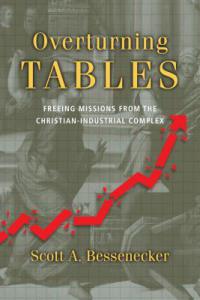
Overturning Tables: Freeing Missions from the Christian-Industrial Complex, Scott Bessenecker. Downers Grove, IL: InterVarsity Press, 2014
Summary: Scott Bessenecker argues that Western missions efforts are often captive to corporate culture and practices inconsistent with efforts to reach across cultures and to the marginal peoples outside the corporate world.
“Business as mission is not what I am addressing in this book; my concern is mission as business.”
Scott Bessenecker, a missions leader working in collegiate ministry, contends that Western missions efforts are shaped more by the corporate and business culture of the Western world, and often codified in government regulation of non-profits, than they are reflective of the values, and practices of Jesus and early Christians, as well as Christian missions arising from more marginalized peoples. He calls this the “Christian industrial complex.”
In “A Tale of Two Missions” he traces the growth of two divergent models in the early 1800s. One is the missions board, headed up by church and corporate leaders that raises large sums to send missionaries with modest but western accommodations (sometimes compounds). He contrasts this with the mission started by George Leile, a former slave who goes without board or church support to Jamaica to preach among slaves, supporting himself by his own labor.
In succeeding chapters he argues for a series of shifts that reflect what he believes is a move to a more gospel of the kingdom-centered approach to missions. He calls for movement from corporate to more local, indigenous efforts. He pleads for a more prophetically driven rather than finance and “profit” driven approach. He argues for a gospel not just centered on individual converts but also concerned for the cosmos. He argues for a move from an individually focused mission enterprise to communal solidarity on both the sending and receiving end where churches really send teams into mission, and those teams integrate with local leadership. He argues for ministries that reach the margins of societies, not the middle class mainstream that our corporate models direct us toward. He calls us away from metrics being the only measures of growth to the pursuit of flourishing people.
This is hard-hitting stuff. One of the things he touches on is that our Western organizations are set up within the constraints of 501(c)(3) status that affords tax exempt and tax deductible status but comes with certain requirements. Westerners who want to do mission in a different way may need to be willing to do this without these structures-finding alternate means of support, working under agencies in other countries, living at different standards.
The book is also inspiring because the rest of the world isn’t waiting for Christians in the West to change. Bessenecker tells a number of stories of efforts in the Majority World that are bringing the gospel to marginal peoples unreached by more traditional efforts. Nigerians are planting churches in Mexico, Koreans in Mongolia and much more.
There is a challenge in every culture that we try to fill old wineskins reflecting our cultural captivities with the new wine of the message of Jesus. Missions leaders need to consider the outcome of this story which is that the wineskins end up bursting, unless new wineskins are found. Bessenecker’s book gives us some notions of the shape and character of these new wineskins.
Editor’s Note: Thank-you to Bob Trube for sharing his reviews with Emerging Scholars! Bob first posted the above review on Bob on Books. ~ Thomas B. Grosh IV, Associate Director, Emerging Scholars Network
Bob Trube is Associate Director of Faculty Ministry and Director of the Emerging Scholars Network. He blogs on books regularly at bobonbooks.com. He resides in Columbus, Ohio, with Marilyn and enjoys reading, gardening, choral singing, and plein air painting.

Leave a Reply